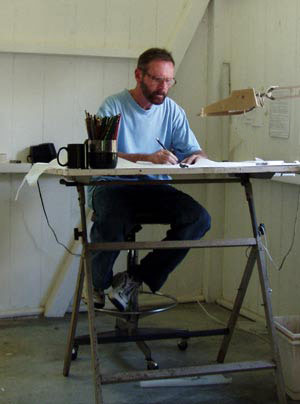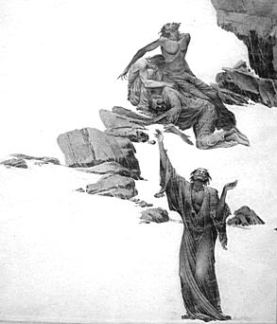I N T E R V I E W S : Stuart Hahn
Q. You began your career in advertising and then shifted to
art making, tell me about your shift in perspective. Or did
a shift occur?
A. I’d been quietly working at home, away and apart from
advertising all the while I was employed, fulfilling, I
guess, a need to break away from much of the banality in
that field and also the need to lash out at the
establishment – as youngsters need to do. The work was
personal, sexual and private, I still haven’t shown all
of it. So it wasn’t difficult to move out of the
advertising “perspective” into my own
“perspective” – that had always been there and
going on. I should say, though, that despite the constraints
of the job – I mean the straitjacket of having to work to
the strict dictates and whims of creative directors (as the
job could really only entail, after all), I was able to gain
hugely in terms of technique and discipline – PATIENCE!
Nothing is a total waste if you apply yourself. Oh – and
the money wasn’t bad either!
Q. You told me that you went to boarding school in
Barbados. What was that experience like, particularly as it
related to your art learning?
A. That amounted to my only formal education. A wonderful
young teacher right out of art school in England who not
only took me and two other boys to A level before we even
sat our Os, but took us to art shows and various local
places of interest – chalky mount, a village potter society
perched on a hillside ridge where they did everything from
digging the clay to firing the pots in their homemade kilns
– the museum, dinner at her home with her husband who was
teaching at Lodge School a few miles away from Mapps.
I’ll never forget her.
She must have been pretty radical for her time – encouraged us
to experiment, so I did some paintings with grasses and leaves
and berries from the school compound – stuff like that.
Q. I remember when I first saw your work, I was a teenager
and I was so excited by it. ‘Ti Jean and his brothers.’
There were line drawings and coloured pencil drawings and
it was local, yet felt like something you could buy in New
York. Was that your first foray into publishing your
illustrations? And what was the process like?
A. Mostly, I remember trying desperately to NOT imitate Alf
Cadillo who was, and is still, the authentic folklorist of
the day and who so many people seemed to be falling in step
behind in outright imitation. My own models were more the
great turn of the century (20th century!) children’s
book illustrators – Racham, Dullac, Heath-Robinson,
Beardsley, Von Bayos – and the great graphic pieces of Mucha
– who I still revere – shamelessly!
The actual “process” was to try to amplify the
text in the sense of adding to it – not only what was
actually there, but what was also implied – a kind
expansiveness and liberty-taking that I always thought could
only enhance the full experience of the reader and of course
the child looking at the pictures as the reader read. Lots
of detail, too. I know there’s a school of thinking that
for children it should be honed down to the barest
essentials – and that’s fine for those who can make that
work for then – Maurice Sendak, for instance. But my own
memory of picture books is of pouring over the pictures and
picking out the little details – the faces in the bark of
the Racham trees, how the branches of the trees turn to
limbs and fingers, the faces peeping out of the shadows. And
I wanted to give it something romantically magical too, even
though our own folk lore is pretty straightforwardly lacking
in that, is more about frightening little children from
running out into the dark because the douens will kidnap
you! It was not easy – for me – to apply kind of delicacy –
as I saw it – to our own stories. Ti Jean and his Brothers
is NOT a “pleasant” story. But then children also
like to be frightened, too – love stories of things that
lurk in the dark, ready to jump out on you, so……
Q. You do a lot of mythology drawing, elaborate…
A. A natural progression from fairy and folk tales? Basically
stories to tell – narratives to fill out – but of course
much, much more than that. Childhood spent being read to
from the legends and myths of the world. Totally embedded
in my psyche. There was a time when I thought I had to
“creolize” these in order to make them
“relevant” to Trinidad. But that doesn’t seem
appropriate or necessary any more. Myths and legends exist
in their own reality and so I let the drawings evolve by a
kind of intuitive process – something like Rousseau, but of
course very,very different.
Q. How do you work? What informs your process?
A. Hmmmmmm….. Strangely enough sometimes even something by
the very fact its revultion can turn into obsession and
fascination. Indian Hindu miniatures for instance – at
first something so horrible, to me, about the rendering of
the hands and feet, the huge eyes, the total disinterest in
characterization – but I just couldn’t let go of it, and now
I’m doing my own version!
But you want something more specific. It’s all mostly from
literature. The Idea first – the thumbnails – then the
hard work of the actual research and the working up of the
full size picture, which often grows on itself.
Often, too, one picture will come form another, a kind of
self-canibalization.
Q. You did a series on the Kama Sutra, the sexual content
of your work must raise some reaction from the public…
A. You might think so, but I don’t hear any, not to my face,
anyway. Maybe YOU could tell me what the reaction is!
I can say that there is a difficulty with selling that
stuff – here. But that’s a whole other discussion!
Q. What are some of the challenges and triumphs of working
as you do?
A. Challenges? – a great friend said I was an anachronism,
that the stories I draw are just no longer known here and
have no resonance or relevance. They certainly used to be
part and parcel of general education, but no more. I’ve
literally attached explanatory stories to the work for
exhibition in the hope of addressing that challenge – but I
don’t think people read them – well, people don’t read, anyway
– period! And yet those ancient myths ARE relevant – think
Walcott’s Omeros! And of course the Ramayan is with us
in the very flesh every year in rural communities all over
the island.
Q. What do you wish people could know about your work?
A. I thought these questions would get EASIER!
I think I’d like them to know its THERE, see the WORK that
has gone into it – the MANNERS, as Leroi Clerk says! That
the joy of art is actually in the WORK of it. Hopefully that
that can be seen in at least a little of what I do.
Also that there are ways of seeing the world that are new
and different and equally relevant. But let me stop beating
about the bush here. What I’m saying is that gay men and
women should approach their work, their art, in fact can ONLY
approach it, if they are to be sincere and honest, from the
position of their own sexual orientation, and that has its
own value, its own truth. I’m tired of that being
invalidated – here! – by ignorance and intolerance and
prejudice. There are gay artists working here who are
hiding or at the very least side-stepping the fact of their
sexuality in their work – as if that could ever be hidden,
anyway. I wish they could have the honesty and courage to
come out of the closet and work WITH the conviction and
strength of their sexuality, see it in fact as their
greatest uniqueness. Do I have to remind anyone that the
greatest artists in the world (and no quibbling about it!),
Michelangelo and Da Vinci, were homosexuals?
And isn’t the ceiling of the Sistine Chapel, among all else
that it is, a paean of love to the beauty of the male body
and psyche? And are we not ALL better for it?
Q. Having the opportunity, what would you like to do, or
have not done as yet?
A. Simple – work and more work – so long as God spare life!
Gallery: Stuart Hahn








You art work is Amazing,Inspiring ,and it is Master art work….Handbound